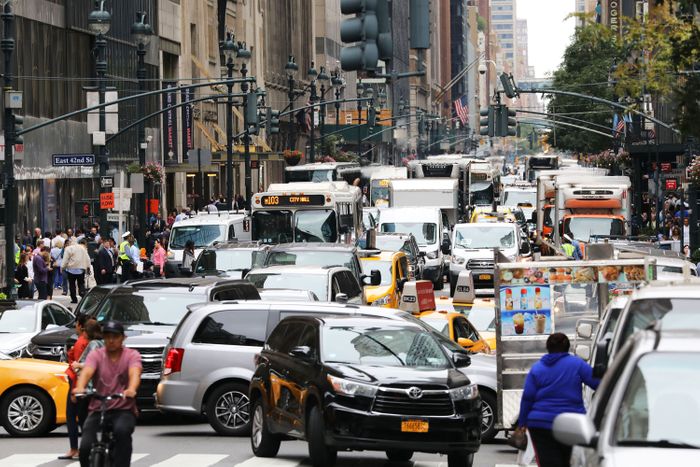
The first congestion-pricing plan in the country is tentatively set to move forward. The Federal Highway Administration has given its blessing to New York City’s plan after an environmental review determined a “Finding of No Significant Impact” over a project area that encompasses 28 counties across three states. In what has become an agonizingly drawn-out process — the state legislature approved congestion pricing in 2019, for those keeping track — the MTA has cleared one more hurdle in its quest to charge drivers to enter Manhattan below 60th Street. To say that the agency could really use the plan’s projected $1 billion in annual revenue is an understatement.
Friday’s announcement was cheered by Kathy Hochul and Eric Adams, but there was discord brewing on the other side of the Hudson: In response to the news of the approval, New Jersey governor Phil Murphy said that he supports the idea “conceptually,” but that the plan places an “unjustified financial burden on the backs of hardworking New Jersey commuters.” While deciding how to fairly toll drivers is critical to the program’s success — which is why the review process included hearing from hundreds of them — it’s a very strange thing for Murphy to say when four out of five people who commute from New Jersey to Manhattan currently ride transit and would, well, benefit from the plan. Nevertheless, Murphy and New Jersey congressman Josh Gottheimer (whose “Stay in Jersey” campaign accidentally touted the benefits of congestion pricing) have threatened legal and legislative action.
There’s a lot more beyond a tantalizingly steady stream of transit revenue riding on New York’s success. Congestion pricing is an idea that’s been proposed in one form or another for decades, but the timing is particularly auspicious as New York City leaders fret about drawing more foot traffic and commercial tenants to the very same central business district. What happens here will also reverberate far beyond the region to determine the path forward for other U.S. cities hoping to charge drivers to access their downtowns. Everything from the pricing — which the MTA has said could range between $5 to $23 per car and would fluctuate based on the time of day — to deciding what transit improvements are prioritized for funding will set standards for other cities to implement. It’s important for the MTA to get this right.
And that’s the next, extremely critical part of the process. A six-member review board — including Adams’s nominee, Transport Workers Union president John Samuelsen — will make their recommendations for how the tolling scheme should work, including proposing any carve-outs or exemptions for certain drivers or vehicles. The MTA will then take the board’s recommendations, draw up the final plan, and lay out the steps for implementation, which will include deploying the physical tolling infrastructure throughout Manhattan. This part could still take a year or so, but the end is finally in sight — buckle up, because congestion pricing is likely coming in 2024.




